Hello, and welcome to Hyouka Saturdays! For the next twenty-one weeks, I’ll be watching and writing up an episode of Kyoto Animation’s well-loved 2012 show, Hyouka. I’ve heard many good things and been told many times that it’s a show I would like, so I’m giving it a go.
Hope you all enjoy the ride! If you haven’t seen it before, feel free to watch along with me! I’d be glad to have company~
Right from the opening shot, Hyouka sets up an expectation: this is a place we’ve been before. Of course, that’s assuming you’ve watched anime before, as the sakura blossom is the de facto signal for a high school setting—presumably at the beginning of the school year. And as protagonist Oreki’s (or is Houtarou a better way of calling him?) monologue verifies seconds later, that’s exactly where we are.
As genuine and emotionally transparent as Hyouka the show seems (as opposed the the clearly oblique Oreki) so far, there’s also a certain feeling of gentle irony that pervades this premiere episode—this may be a place we’ve been before, with tropes we’ve seen before, but there’s also something special here that we only just begin to grasp by the end of the first episode. And this irony pops up elsewhere—showing up in places as obvious as the contrast between Oreki’s stated desire for a “gray” life and his correspondingly inability to resist the overwhelming color that Chitanda embodies and as subtle as Oreki’s silly introduction of Satoshi as a “‘fake’ man of the world,” when it’s clear that Oreki himself far better fits that silly label.
Still, these are little things in a show about little things. About the cheerfully prideful names high school kids give themselves. About the sullen ideologies they give themselves to uphold. About the curiosity over such a small incident as a locked door—and the way that curiosity suddenly eclipses the smallness of a sunset scene for a moment in a burst of color [1].
But I may be getting ahead of myself here. Sorry about that. It was an impressive first episode on a lot of fronts, but it may be best at this point to pause and simply reflect on my impressions of the characters themselves, starting with Oreki. Contrary to Oreki himself, I don’t believe his trademark characteristic to be “energy-conservation,” but rather “lack of awe.” There are plenty of stories about a colorless, dull boy being shown the color of the world by a girl, but I don’t exactly get the impression that’s Hyouka‘s goal. Although Chitanda’s highlight scenes are dominated by lush colors duplicated nowhere else in the show, these moments strike me as being more about awe—about something unknown, yet fascinating.
Oreki, as we see almost immediately, is a thoughtful, observant young man. He notices things, pays attention to them, thinks through things, considers the implications, feels bad about tricking Chitanda in order to preserve his peace, and understands a lot. Yet, in Chitanda, there appears to be something overwhelming and engaging—something he can’t just grasp by watching passively. And for someone concerned with preserving a peaceful, gray life, someone who may even wish he was different than he is, a person of mysteries like Chitanda represents more than just “bringing color into a gray life.” She represents a chance to engage, and change. Oreki may not consciously want this right now. But already his reactions to Chitanda obviously indicate there is a level of fascination there he can’t explain right now—it’s something a little bit magical.
Chitanda herself is more an enigma than she seems at first blush, a top student from a good family with bright eyes and moe looks and an inexplicable curiosity for rather mundane occurrences. The Classic Club’s first “mystery,” that of the locked door, is a delightfully little entrance into the world of mysteries—the key, if you will, through the door. At face value, she seems nothing more than a vaguely childish cute anime girl, but hints at her motivations (“personal reasons”) and her exaggerated interest in learning things suggest there’s a lot more to her than meets the eye [2]. To me, she seems to exude a sense of semi-confident naivety, or perhaps more relevantly, a distinct sense of awe (in other words, the very thing Oreki currently lacks).
And then, there’s database Satoshi, who may very well be the most grounded and understanding of the three so far. He clearly understands Oreki better than Oreki understands himself, but that’s not uncommon with long-time friends (and also because others can often see into us more easily than we can into ourselves). Rather, Satoshi seems “wise” (at least as much as a high school kid can be) and possessing of an energetic, generous spirit that makes him a fun match alongside the gloomy Oreki. I get the sense that Satoshi is simply a guy who loves the things he can see right in front of him—that includes people, situations, and activities. He’s not all that complex, but his simplicity allows him to understand that Oreki’s nuances come from pretty basic places. I’m looking forward to seeing how their relationship continues to play out.
On top of all this, then, is Kyoto Animation’s stunning visual work, which includes such gorgeous tricks as visual echos, peaceful overhead shots, and snappy editing that can’t be done justice by mere screenshots. Hyouka appears deeply indebted to The Melancholy of Haruhi Suzumiya in many ways, as it should (director Yasuhiro Takemoto directed The Disappearance of Haruhi Suzumiya and co-directed the main series’ second season)—not least of which is the relaxed pace Hyouka takes through its conversations and story. It’s not a dull experience by any means, but it is a measured, contemplative one, even in its most dynamic moments.
To me, the speaks of confidence. And besides the usual Kyoto Animation strength (tiny bits of excellent, important character animation and stellar production values), Hyouka just feels graceful and elegant. Not in any kind of grand way, but in a way that speaks of care, love, and attention. It’s like a garden in a light rain shower. And it’s a delight so far.
[1] I’d like to note that the absolute wonderment of inflamed coloration that explodes when Chitanda pleads with Oreki to help her solve the mystery is foreshadowed by the first time she approached him, shortly after they meet in the club room for the first time. Although the episode is dominated by the dull colors of sunset and a rainy afternoon, when Chitanda steps towards Oreki and the camera cuts from her feet to a medium long shot backgrounded by the windows, the same green and yellow lights into which Oreki is later immersed in full appear through the panes.
[2] Sorry, I couldn’t help it.

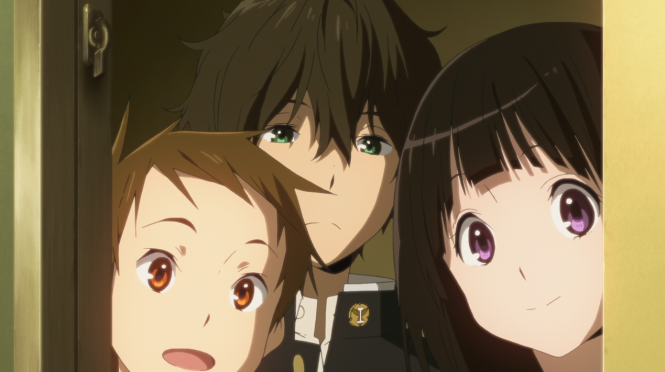
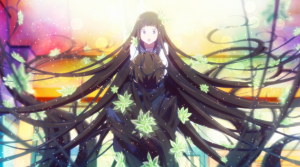
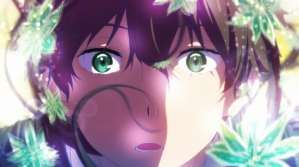

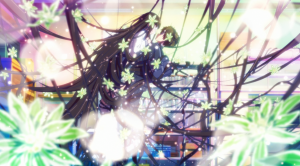
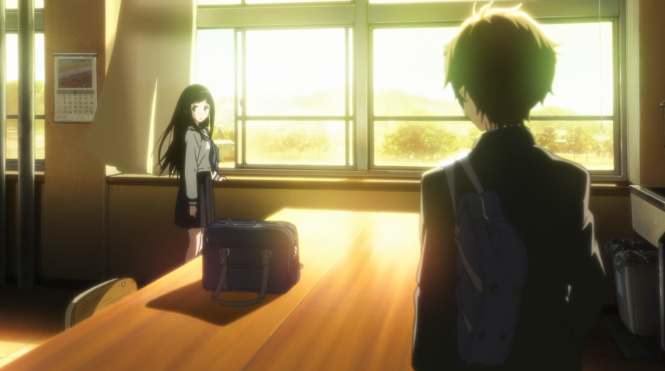
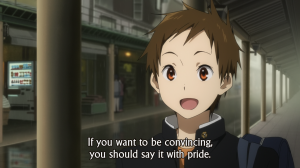
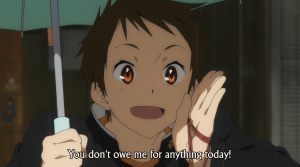
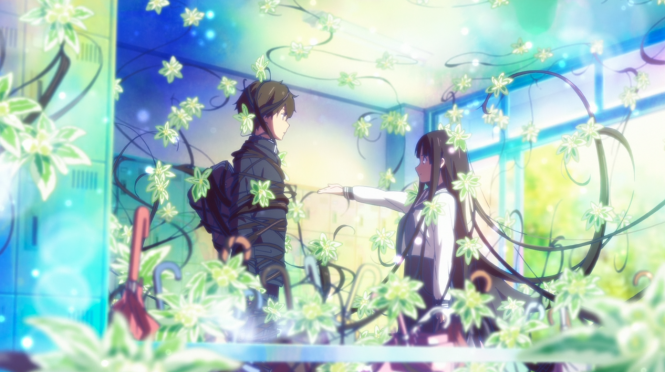
Enjoy the ride!
LikeLike
I’m planning to!
LikeLiked by 1 person
Yesssss! You’re doing Hyouka! Loving the emphasis on the visual artistry in your post (and your writing in general). It’s a definite fit for Hyouka, because it’s seriously one of the prettiest anime ever. Plus, all the symbolism and motifs are used really intelligently, so you’ll definitely have a blast.
You should watch out for Satoshi. You say he’s simple, and he is so far, but he’s probably the most complex character in the anime. Oh man can’t wait till you get to my favourite episodes
insert fanboy-gasms
LikeLike
Yeah, so far Hyouka doesn’t seem completely focused on visuals as a method of communication—rather, it leans into them when it needs to, which is fine—but there’s still a ton to dig out of each episode.
And yeah, I figured Satoshi would eventually build in complexity given the nuance this show has given to Chitanda and Oreki already.
LikeLike
Uh oh. Looks like I’ll have to move my timetable for starting this series up from “in a couple of months” to “in a couple of weeks” instead. I still want to get through Air first, though.
LikeLike
Well, I’ll be watching it for a couple of months, so you have plenty of time!
LikeLike
I know it’s just a silly assertion of personal taste, but in my opinion, Hyouka is the best anime ever made. The artwork, the direction, the dialogue, and the interplay between characters put it head and shoulders above anything else I’ve seen, so I’m always delighted to read someone else’s thoughts upon viewing it.
There are a million coming-of-age stories in literature, TV and movies, but none has ever felt so incisive, or beautiful, as Hyouka…
LikeLike
It’s not silly! If it’s your pick for best ever, that’s your pick! Be proud of it!
That being said, all the positive feedback surrounding the show is really exciting for me—makes me feel like I made a good choice in deciding to write about it.
LikeLike
D’aww, I love this show. Weirdly enough though, I didn’t love it at first – it wasn’t until my second try that I really managed to feel anything. When I did though, I REALLY did, and now I can’t not gush about it. Definitely my favourite KyoAni title to date, and that’s even taking into my account my dopey affection for Free!.
LikeLike
Hey, you’re back! And wow, even topping, Free!, huh? This really seems to be KyoAni at its best for a lot of people.
LikeLike
Hyouka was the last good KyoAni show before Hibike Euphonium came along. For me, it was such a drastic fall, that I’ve come to talk about pre-Hyouka and post-Hyouka KyoAni. It’s a subtle show, and while it’s obviously pretty, it takes a while to work its magic. Most of the clues to what’s going on with the characters will be found in the cinematography rather than the dialogue. I’m happy to see that you distrust the dialogue (though my interpretations early on were different).
Oreki was, for me, an easy entry-point to the show. I instinctively understood where he came from, and I never really changed my mind about that.
I found Chitanda extremely irritating from the beginning, and it took me almost all the show to really understand what she does and why.
Staoshi was my favoutie character from episode one, and he never yielded that spot. (He’ll only get better.) In fact, early on Satoshi was the only draw for me. I found both Oreki and Chitanda rather uninteresting: Oreki felt too familiar, and Chitanda too irritating.
LikeLike
For my part, I’ve seen almost everything KyoAni’s done since Hyouka, so it’s interesting going backwards (although, as I’ve noted, I’ve already seen and loved Haruhi).
There really does seem to be a lot going on under the surface, and to some extent I’m a bit afraid my expectations for the show will get in the way of me liking it—that is, that I’ll be expecting to find so much stuff that it keeps me from noticing other things.
Oreki definitely does feel familiar—his salute to “energy-expending people” reminded me very strongly of a line I feel I’ve seen elsewhere (maybe Kyon?), but I couldn’t quite figure out where.
LikeLike
Hm, Kyon sounds plausible. But I’ve never actually made the connection. Now, I keep comparing Houtaro to Hachiman from Oregairu, but I couldn’t have done that back then, since I saw Hyouka first. Houtaro clicked into place for me during a rather prominent billboard scene (they were looking at club ads, as far as I remember). The scene should be in one of the early episodes; you’ll know it when you see it. (Maybe it was in the first already? I’m thinking episode 2, 3 the latest.)
Satoshi reminded me of a popular type, too. A good example is Souma from Working, except less type and more person.
It’s very hard to remember first impressions. I’ve seen a lot of anime since then. Also, I’ve never re-watched the show. I’m sure it’d be totally different, if you re-watch it knowing everything. I wasn’t paying too much attention in the early episodes; the show crept up on me.
LikeLike
Annnd Hachiman was totally it! Thanks! Also, I definitely see the Satoshi-Souma comparison, at least at a very general level.
LikeLike
I’ve been reading through an old Hyouka-thread I participated in. Turns out the billboard scene was in episode one. The following is what I had to say about it back then. The date was the 12th of May in 2012 (that would have been around episode 3 or 4):
“Most people look at the board and filter out all the things that aren’t interesting. Houtaro seems not to do this. Instead he takes it all in and has to process it all. That leads him to having no clear interest, and it also means that merely looking at clutter is exhausting, in a way that others don’t understand.
Here’s my hypothesis: he needs to keep to his motto, because reducing the world to a set of currently relevant relation nodes is already hard work. He simply expends more energy perceiving the world in the first place than we do. (This is similar to some form of autism, but he’s not there quite yet.)”
The fun thing is that even after finishing the show I’m not sure the interpretation is correct. Hyouka really is a good show. Heh.
LikeLike
Finally! Maybe I’ll rewatch along with the daily posts. (I have not finished the show.)
LikeLike
Weekly posts! Maybe that’ll give you a batter chance of keeping up!
LikeLike
Somehow I read the whole thing as daily…. T.T
LikeLike
Is there a legal streaming venue for this in the US?
LikeLike
Sadly, Hyouka has never been licensed (for streaming or physical release) in the West. I dunno why, considering it was quite popular in Japan, but I suppose it wasn’t released in the midst of the huge licensing bubble that’s going on today and also perhaps doesn’t fit the mold of what many Western companies would consider a potential success.
LikeLike
Ah, that’s unfortunate. Wish I could watch along. Looks like an interesting series, but I’m really trying to limit my choices to legal options.
LikeLike
The best Kyoto Animation show.
I’m at the school festival chapters now.
The art direction, character designs, background art and characters are fantastic. Chitanda Eru is one of the best characters in recent anime.
I don’t know why they added that first ending, with the sexualized style, immodest clothings, the camera shots, and the yuri elements (?).
There is a pool episode too, I think it was an special bundled with the blu-ray and dvd versions. Although it didn’t felt too much out of character compared to the first ed. Still, Chitanda felt like forced into her swimsuit, since she tried to cover herself frequently with her arms.
The onsen episode (7) was surprisingly more modest than similar situations in other series, although some camera shots could have been avoided.
LikeLike